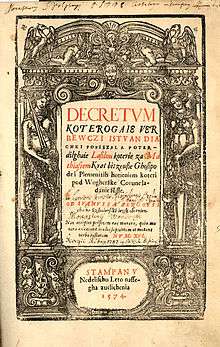István Werbőczy
| István Werbőczy | |
|---|---|
 | |
| Palatine of Hungary | |
| Reign | 6 July 1525 – 24 April 1526 |
| Predecessor | István Báthory |
| Successor | István Báthory |
| Born |
c. 1458 Verbőc, Kingdom of Hungary (today: Verbovec, Ukraine) |
| Died |
October 13, 1541 Budin, Budin Eyalet, Ottoman Hungary (today: Budapest, Hungary) |
| Noble family | House of Werbőczy |
| Spouse(s) |
1. from Szobi family 2. Katalin Hercegh 3. Anna Surányi |
|
Issue
Imre Werbőczy Erzsébet Werbőczy | |
| Father | Osvát Werbőczy |
| Mother | Apollónia Deák |
| Signature | Werbőczy István signature.jpg |
| Occupation | Jurist, Politician |
István Werbőczy or Stephen Werbőcz (also spelled Verbőczy; 1458?[1] – 1541) was a Hungarian legal theorist and statesman, author of the Hungarian Customary Law, who first became known as a scholar and theologian of such eminence that he was appointed to accompany the along with emperor Charles V to Worms, to take up the cudgels against Martin Luther.
Life

He began his political career as the deputy of Ugocsa County to the diet of 1498, where his eloquence and scholarship had a great effect in procuring the extension of the privileges of the gentry and the exclusion of all foreign competitors for the Hungarian throne in future elections. He was the spokesman and leader of the gentry against the magnates and prelates at the diets of 1500, 1501 and 1505. At the last diet he insisted, in his petition to the king, that the law should be binding upon all the gentry alike, and firmly established in the minds of the people the principle of a national monarchy.[2]
The most striking proof of his popularity at this time is the fact that the diet voted him two denarii per hearth for his services in 1505, a circumstance unexampled in Hungarian history. In 1517 Werbőczy was appointed the guardian of the infant Louis II, and was sent on a foreign mission to solicit the aid of Christendom against the Turks. On his return he found the strife of parties fiercer than ever and the whole country in a state of anarchy.[2]
At the diet of Hatvan, on 25 June 1525, he delivered a reconciliatory oration which so affected the assembly that it elected him palatine. During the brief time he held that office, he unselfishly and courageously endeavoured to serve both king and people by humbling the pride of the magnates who were primarily responsible for the dilapidation of the realm. But he was deposed at the following diet, and retired from public life until the election of János Szapolyai, who realized his theory of a national king and from whom he accepted the chancellorship. He now devoted himself entirely to the study of jurisprudence, and the result of his labors was the famous Opus tripartitum juris consuetudinarii inclyti regni hungariae (short form: Tripartitum), which was the de facto law-book of Hungary until 1848, but in 1945 some laws of inheritence were still regulated by this work.[2]
The full Latin text (with English translation) of Werbőczy's Tripartitum (as printed by Singrenius in 1517) is now published as The customary law of the renowned Kingdom of Hungary: a work in three parts, the "Tripartitum" = Tripartitum opus iuris consuetudinarii inclyti regni Hungariæ; edited and translated by János M. Bak, Péter Banyó, and Martyn Rady; with an introductory study by László Péter; Schlacks and CEU Press, Idyllwild, CA, and Budapest, 2005.
References
- ↑ Kármán and Kunčević 2013, p. 68.
- 1 2 3 Chisholm 1911.
- Attribution

Bibliography
- Kármán, Gábor; Kunčević, Lovro (2013). The European Tributary States of the Ottoman Empire in the Sixteenth and Seventeenth Centuries. Leiden: Brill. ISBN 9789004246065.
| Political offices | ||
|---|---|---|
| Preceded by János Erdődy |
Chief justice 1516–1525 |
Succeeded by Miklós Thuróczy |
| Preceded by Stephen Báthory |
Palatine of Hungary 1525–1526 |
Succeeded by Stephen Báthory |